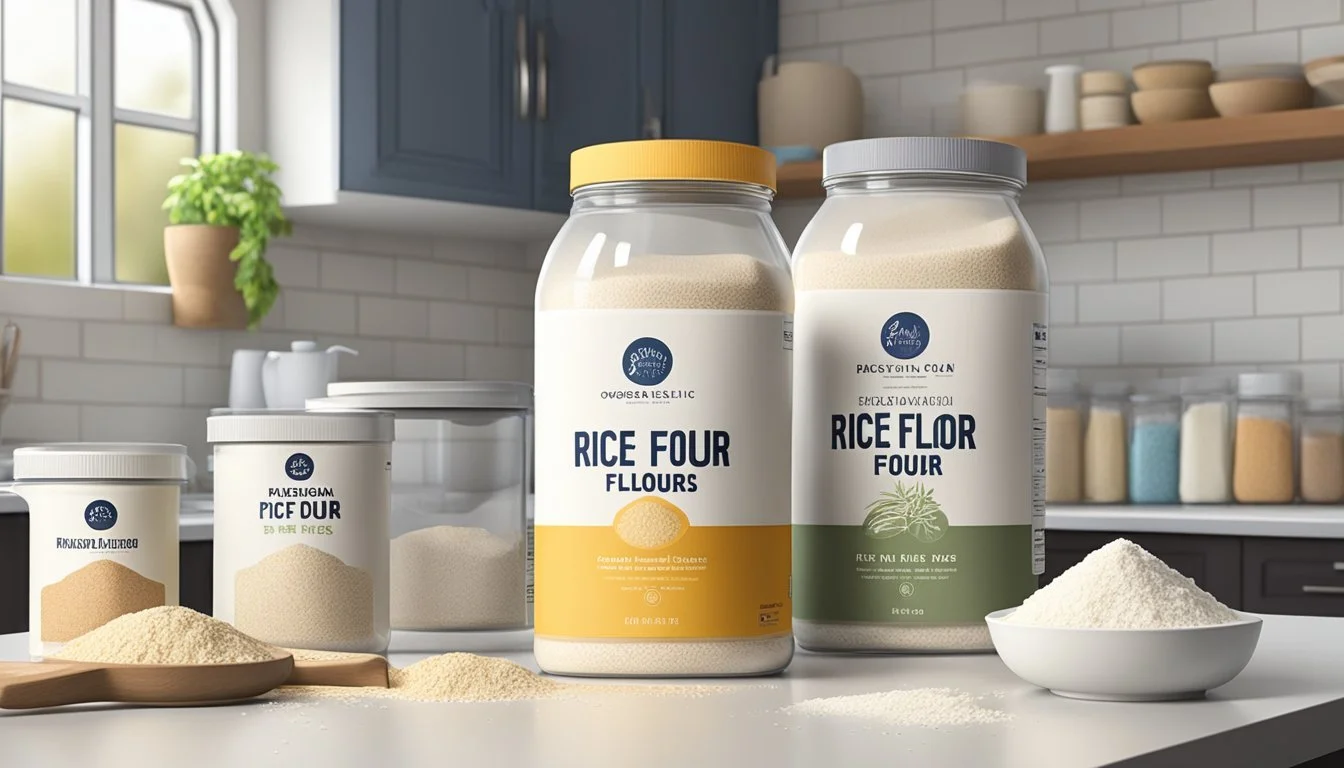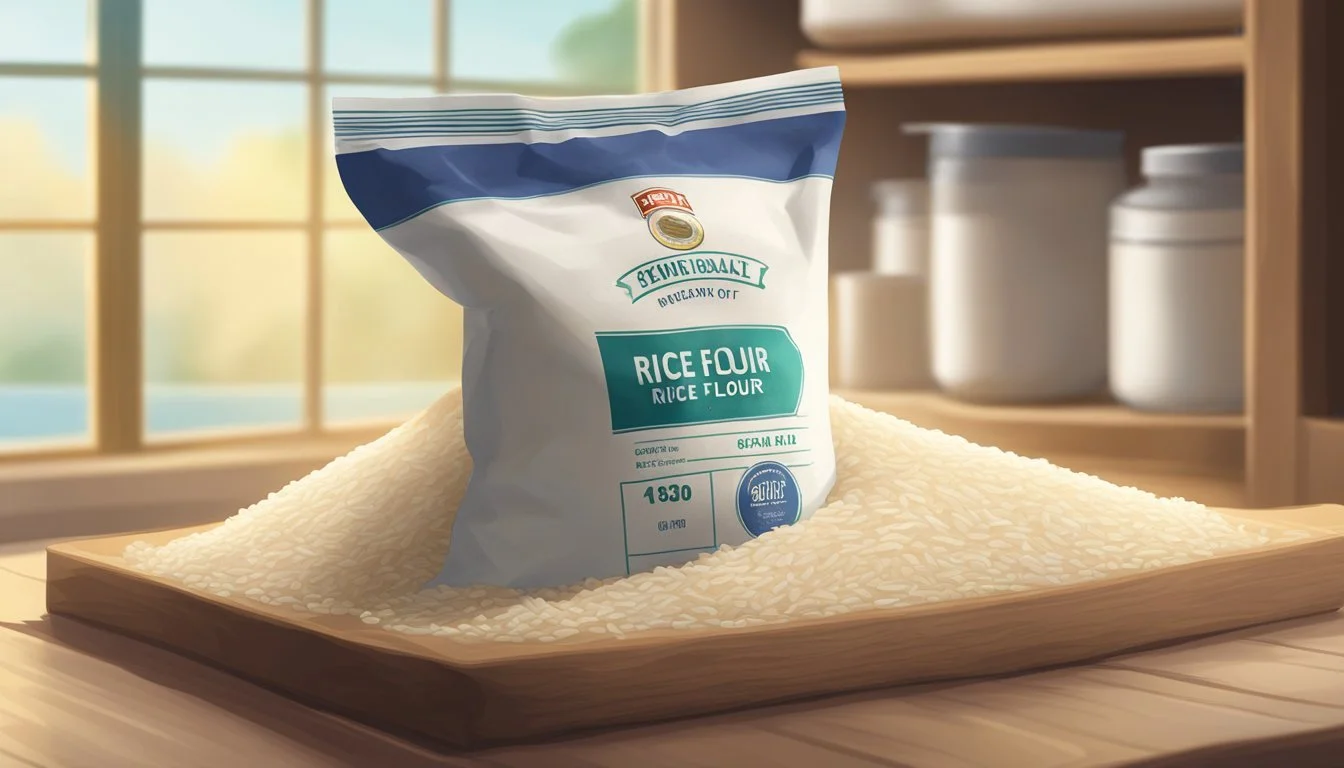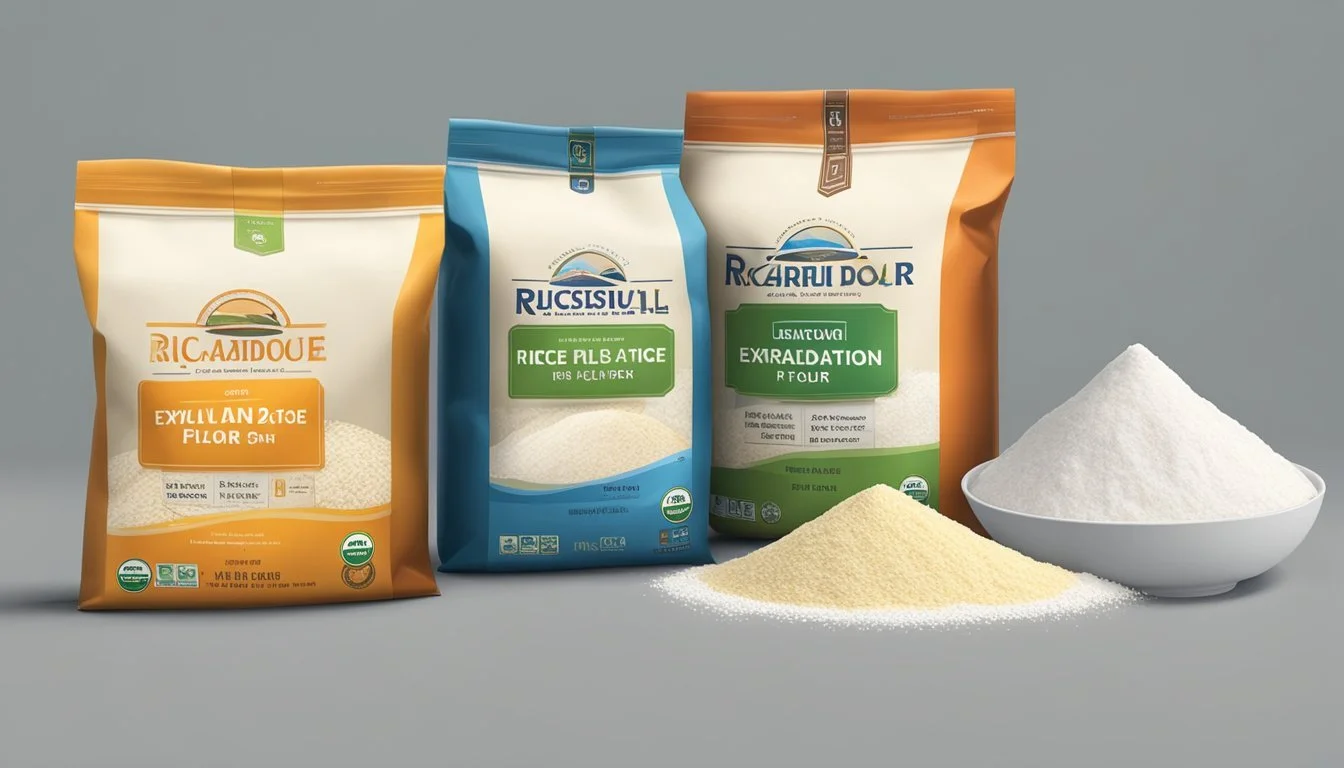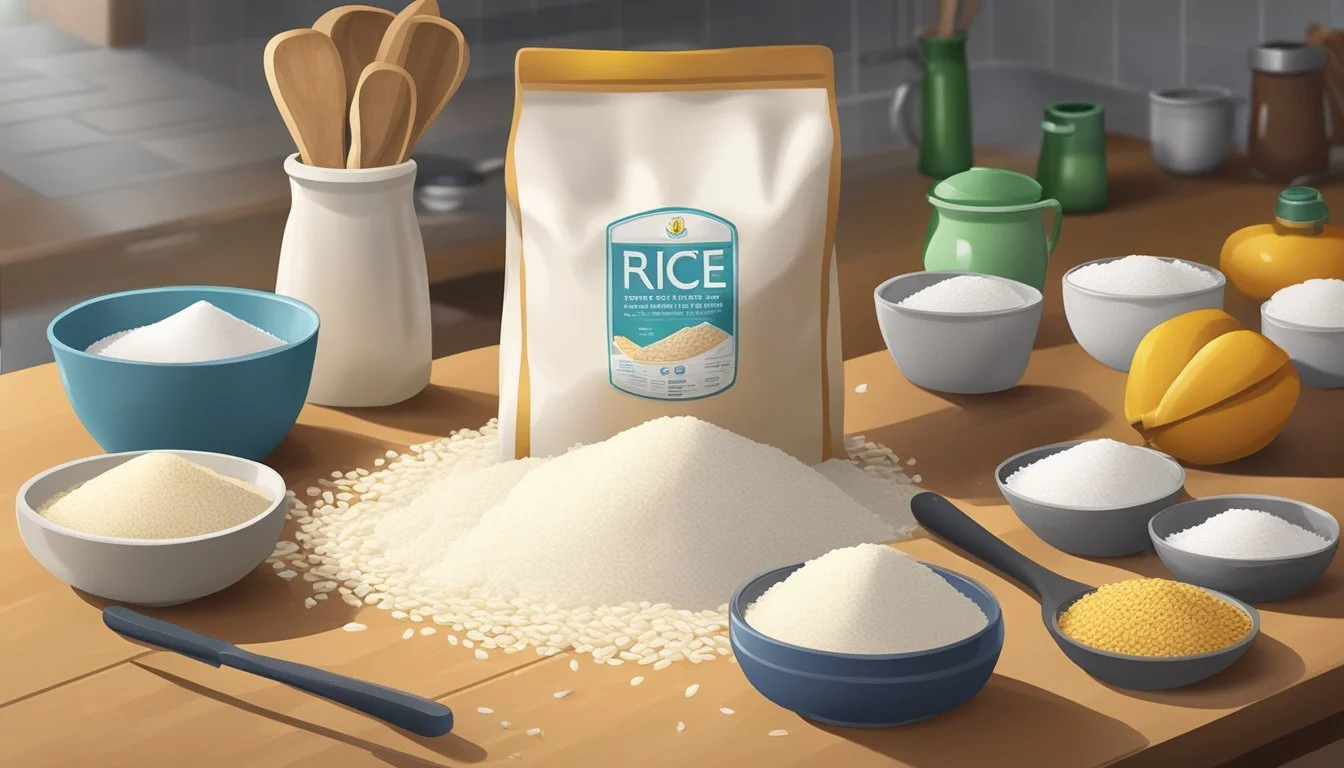How Long Does Rice Flour Last?
Shelf Life and Storage Tips
Rice (What wine goes well with rice?) flour, a staple ingredient in gluten-free baking and numerous Asian cuisines, has a commendable shelf life compared to other flour varieties. The longevity of rice flour largely hinges on the conditions it's stored under. Unopened and stored in a cool, dry place, rice flour can maintain its quality for up to 2 years. Once opened, its freshness is typically best preserved for 6 to 12 months, although this duration can be extended if the flour is kept refrigerated or frozen.
The quality of rice flour can be compromised over time, leading to it turning rancid. Indicators of spoilage are a sour smell, a change in color, or a clumpy texture, which signal that the flour should not be used. To ensure maximum freshness, it's pivotal to store rice flour in an airtight container away from any sources of moisture and heat, which can accelerate its deterioration.
While rice flour may remain safe to consume for a period beyond its expiration date, its culinary performance might diminish, impacting the taste and texture of finished dishes. It's advisable to perform a quality check if the rice flour has been stored for an extended period, regardless of its expiry date, to determine its suitability for use in recipes.
Types of Rice Flour
Rice flour is typically derived from either white or brown rice, and its variations are prized for their differing qualities and uses, especially within gluten-free cooking.
White Rice Flour
White rice flour (how long does white rice flour last?) is milled from medium- or long-grain white rice. The milling process removes the husk, bran, and germ, resulting in a refined flour with a neutral taste. It's often used as a thickening agent or as a base for gluten-free baking mixes because it creates a light texture in baked goods.
Brown Rice Flour
Brown rice flour is grounded from whole grain brown rice including the bran, providing a richer, nuttier flavor. It's denser than its white counterpart and is frequently used in recipes where a more robust flavor is desired. Brown rice flour also offers additional nutritional value thanks to the presence of the bran.
Gluten-Free Rice Flour
Gluten-free rice flour can be either white or brown rice flour. As the name implies, it does not contain gluten, making it an essential ingredient for those with celiac disease or gluten intolerance. Bakers often use it in combination with other gluten-free flours to achieve the desired consistency in gluten-free recipes.
Spotting Spoilage
Identifying spoilage in rice flour is crucial to ensure food safety. Users must be aware of specific signs that indicate contamination or degradation.
Visual Indicators
When examining rice flour for spoilage, visual cues are the first line of detection. The user should look for any discoloration—white rice flour that appears yellowish or has dark spots may have been compromised. Additionally, the presence of bugs or mold—which can appear as fuzzy spots in various colors—is a clear sign that the flour should not be used. Users are advised to inspect the flour closely, as some contaminants might not be instantly noticeable.
Olfactory Signs
The smell of rice flour is also a potent indicator of its quality. Flour that has gone bad may emit a musty or moldy odor. A rancid or "off" smell is a signal that the flour has been contaminated with moisture and bacteria, leading to spoilage. Users are recommended to trust their sense of smell and discard any flour that does not have the neutral, starchy scent associated with fresh rice flour.
Proper Storage Techniques
The longevity of rice flour significantly depends on proper storage. By controlling the temperature, moisture, and exposure to air, one can extend the shelf life of rice flour.
In the Pantry
Rice flour is best kept in a cool, dark place such as a pantry. Home cooks should place the flour in an airtight container to prevent exposure to humidity and pests. The ideal pantry temperature should stay consistently below 70°F (21°C) to maintain quality.
Plastic containers with tight-fitting lids or sealed plastic bags are suitable options.
Adding oxygen absorbers can help to further preserve the flour's freshness.
Refrigerating
If the pantry is not sufficiently cool or if one has limited space, rice flour may also be stored in the fridge. In this environment, an airtight container is crucial to prevent the rice flour from absorbing odors and moisture from other foods present.
Refrigerator storage is preferred for opened rice flour, extending its life to 6-12 months.
Ensure the fridge maintains a temperature of around 40°F (4°C) for optimal storage conditions.
Freezing
For long-term preservation, freezing is an effective method for storing rice flour. When stored in the freezer, rice flour can remain usable well past its typical shelf life.
Use a plastic container or a plastic bag that is sealed tightly to prevent freezer burn and moisture entry.
The temperature of the freezer should be kept at 0°F (-18°C) or below, which is standard for frozen food storage.
Shelf Life Determinants
The longevity of rice flour's shelf life is influenced by various factors related to packaging and storage conditions, with unopened and opened flour presenting different scenarios.
Unopened Packages
Unopened packages of rice flour can remain stable for a considerable time. When stored in a cool, dry place, the shelf life of rice flour in its original airtight packaging generally extends up to two years. This is contingent upon the best-before date printed on the package, which serves as a manufacturer's estimate of peak quality.
After Opening
Once the package is opened, rice flour's shelf life inevitably shortens due to exposure to air, moisture, and potential contaminants. To preserve its quality, it should be transferred to a sealed, airtight container. In this state, opened rice flour may last for 6 to 12 months. Storing it in the refrigerator or freezer can extend its useable period further. It is important to monitor for signs of spoilage, such as an off smell or the presence of bugs, which indicate that the flour should be discarded regardless of the expiration date.
Maximizing Rice Flour Longevity
When it comes to preserving the quality and extending the longevity of rice flour, a few key storage principles should be adhered to. The emphasis should be on creating an environment that minimizes exposure to elements that can accelerate spoilage, such as heat, light, oxygen, and moisture.
Storage Location: A cool, dry place away from any heat sources is ideal for storing rice flour. Cabinets or pantries that do not face direct sunlight help protect the flour from temperature fluctuations and light.
Airtight Containers: To prevent moisture absorption and oxygen exposure, rice flour should be kept in airtight containers. This barrier significantly contributes to maintaining freshness and deterring pantry pests.
Techniques to Prolong Shelf Life:
Keep the rice flour in its original packaging only if the packaging is robust and sealable. Otherwise, transfer it to an airtight container.
Label the container with the date of storage to keep track of its age.
Environmental Control:
Temperature: Aim for stable temperature control; it’s vital for preventing the degradation of rice flour.
Light: Store the flour in opaque containers if possible, as this will shield it from light, helping to preserve its nutritional value and taste.
Moisture: Silica gel packets can be added to the container to ward off moisture.
Using these storage strategies can effectively maximize the shelf life of rice flour, ensuring that it remains a reliable staple in any kitchen for an extended period.
Health and Safety Considerations
When consuming rice flour past its expiration date, one must be mindful of health and safety implications including food poisoning risks and the possibility of consuming rancid product.
Consumption Risks
Expired rice flour can pose several health risks. It may become rancid, developing an off smell and taste, which not only compromises quality but can also be harmful if ingested. Rancidity is a result of fat oxidation, which can occur in rice flour due to its natural oils. Ingesting rancid rice flour may lead to food poisoning, with symptoms such as vomiting and diarrhea. Furthermore, spoiled rice flour might contain harmful compounds like mycotoxins, produced by certain molds that can grow on improperly stored grain-based products. These toxins are linked to long-term health risks, such as cancer.
Preventative Measures
To ensure safety, rice flour should be stored in an airtight container in a cool, dry place, away from heat and moisture. For extended shelf life, storing rice flour in the refrigerator or freezer is advisable. One should regularly inspect the rice flour for:
Changes in color
Unusual odors
Signs of mold or pest infestation
If any of these signs are present, the flour is no longer safe for consumption and should be discarded immediately. Always prioritize safety and health by refraining from using rice flour that shows any indication of spoilage.
Comparison to Other Flours
When examining the shelf life of flours, rice flour is often contrasted with both traditional wheat flour and other gluten-free alternatives. Its shelf life, storage conditions, and usage differ significantly, providing a range of options for those with specific dietary needs or preferences.
Wheat Flour vs Rice Flour
Wheat Flour: Includes white flour and whole-wheat flour, both derived from wheat grains.
White Flour: White flour, milled from only the endosperm of the wheat kernel, tends to have a shelf life of about 6-12 months when stored properly in a cool, dry place.
Whole-Wheat Flour: Contains the bran and germ, making it more nutritious but also causing it to spoil faster due to higher oil content. It typically lasts 3-6 months.
Rice Flour: A gluten-free alternative made from ground rice.
Shelf Life: Generally lasts about 6 months if stored in a cool, dry place, like a pantry, but can extend to a year if refrigerated.
Storage: Advisable to store in airtight containers to protect from moisture and contaminants.
Other Gluten-Free Alternatives
Coconut Flour and other gluten-free flours have grown in popularity, offering different shelf lives and storage requirements.
Coconut Flour: Known for its high fiber content, coconut flour has a shorter shelf life of about 6 months due to its higher fat content but can last up to a year if stored in the freezer.
Gluten-Free Alternatives: Typically have varied shelf lives depending on their fat and oil content; however, they generally need to be stored in airtight containers, and refrigeration can extend their freshness.
Rice Flour in Cooking and Baking
Rice flour is widely recognized for its gluten-free properties, making it a staple for those avoiding gluten. It imparts a distinct texture to foods and is used for a range of culinary applications from baking breads and cakes to thickening soups and sauces.
Baking Applications
In the realm of baking, rice flour is a favored choice for those seeking gluten-free alternatives. It lends a delicate crumb to cakes and is often used in combination with other flours to achieve a desired texture. Rice flour's fine consistency contributes to a light, airy structure in breads, providing a satisfying crust and tender interior. Notably, its flavor is subtle, allowing other ingredients in recipes to shine through.
Common Baked Goods with Rice Flour:
Gluten-free breads
Tender cakes
Crisp cookies
Pie crusts
Despite its lower protein content compared to wheat flour, when utilized correctly, rice flour can create results that closely mimic the qualities of traditional baked goods.
Cooking Versatility
Rice flour exhibits remarkable versatility in cooking. As a thickening agent, it is seamlessly integrated into sauces and gravies, imparting a smooth, creamy consistency without the heft that wheat flour can sometimes contribute. It also serves as an excellent coating for fried foods (What wine goes well with fried foods?), offering a light, crispy texture that is highly sought after.
Diverse Cooking Uses:
Sauces and gravies
Fried coatings
Noodles and dumplings
Rice flour's neutral flavor ensures that it can be incorporated into various dishes without altering the taste profile.
Understanding Expiration and Best Before Dates
When discussing the longevity of rice flour, it's essential to differentiate between expiration date, best-by date, and best before date.
Expiration Date: This indicates the last day a product is expected to maintain its optimal quality and safety. After this date, rice flour may not only lose its freshness but could also become a health hazard.
Best-By Date: This date informs consumers of the time up to which rice flour will likely be at its best in terms of taste and quality. It is not a safety indicator, and manufacturers often estimate this date conservatively.
Best Before Date: Similar to the best-by date, it conveys the period that the rice flour is expected to retain its ideal quality. After this period, the product might not be at its peak, but it is generally still safe to consume if stored properly.
How to Interpret These Dates:
Before Opening: Rice flour can last beyond its best-by or best before date if unopened and stored in a cool, dry place. Manufacturers typically provide these dates based on optimal storage conditions.
After Opening: Once opened, rice flour's shelf life reduces. Use within six months is recommended for maintaining freshness.
In terms of food storage, these guidelines apply:
Storage Condition Shelf Life Cool, Dry Place Up to 6 months Refrigerator or Freezer 6 - 12 months
If rice flour shows signs of spoilage, such as an off smell or presence of bugs, it should be discarded irrespective of the dates mentioned. Proper food storage plays a crucial role in extending the shelf life of rice flour.
Food Waste and Rice Flour
Rice flour is a staple ingredient in many households and commercial settings. Its processing involves milling rice into a fine powder, which can be used in baking, as a thickening agent, or for making noodles, among other applications. Proper storage of rice flour is crucial to extending its shelf life and reducing food waste.
When it comes to storage, rice flour should be kept in a cool, dry place in an airtight container. This helps prevent the absorption of moisture, which can lead to spoilage. Furthermore, rice flour should be stored away from strong odors and heat sources, as these can degrade the product, affecting its taste and usability.
The shelf life of rice flour is generally about:
Unopened: Up to 2 years when stored correctly.
Opened: 6 to 12 months in a pantry, longer if refrigerated or frozen.
The expiration date on packaging can serve as a guideline; however, rice flour can remain safe to use for periods beyond this date if there are no signs of spoilage, such as:
Odor: A sour or musty smell is indicative of contamination.
Appearance: Mold or discoloration points to spoilage.
Texture: Clumps suggest moisture exposure, which can lead to mold growth.
By understanding and adhering to these storage principles, consumers can ensure that they use rice flour within its optimal period of consumption. This vigilance combats food waste, allowing for economic and environmental benefits.
It is important to conduct regular checks of stored rice flour to detect any early signs of spoilage. Responsibly discarding rice flour that shows deterioration mitigates risks associated with consuming spoiled food products.
Significance of Packaging
The longevity of rice flour is greatly influenced by its packaging. Proper packaging can effectively extend its shelf life by protecting it from various elements that can accelerate spoilage. It is vital that rice flour is kept in an original container that is designed to seal out light and oxygen, both of which can degrade the product over time.
If the original packaging isn't robust enough or if rice flour is purchased in bulk, transferring it to an airtight container is a practical move. Airtight containers offer a beneficial barrier against moisture and pests, both of which can contaminate the flour and render it unusable.
Materials matter when it comes to packaging. A plastic container with a secure lid is commonly recommended, although glass containers may also be used. They must be opaque or stored away from light to preserve the quality of the flour. Exposure to light, just like oxygen and moisture, can affect the flavor and texture of rice flour.
A summary of the key points to consider for packaging:
Original Container: Ideal if it ensures protection from light, oxygen, and moisture.
Airtight Container: Essential for preventing contamination and spoilage.
Material: Plastic or glass are both suitable, with opacity as a preference to mitigate light exposure.
Location: Store in a cool, dry place, away from direct sunlight.
By being attentive to the packaging standards mentioned above, one can maximize the shelf life of rice flour, ensuring its freshness and usability for a considerable duration.
Environmental Factors Affecting Rice Flour
The longevity of rice flour is significantly influenced by environmental factors such as temperature, humidity, light, and oxygen exposure. Proper management of these elements is essential to maintain the quality and extend the shelf life of rice flour.
Temperature and Humidity Controls
Temperature and humidity are critical factors in preserving rice flour. It should be stored in a cool and dry place to prevent spoilage. High temperatures can accelerate the degradation process, while excess moisture can lead to the development of mold and bacterial growth. Therefore, maintaining a stable environment with low humidity levels is crucial for prolonging the shelf life.
Optimal storage conditions:
Temperature: Below 20°C (68°F)
Humidity: 50-60% RH (Relative Humidity)
Light and Oxygen Exposure
Rice flour's quality can degrade with exposure to light and oxygen. Light can induce photo-oxidation, while oxygen can cause rancidity through oxidative reactions. Limiting exposure to these elements helps in keeping the rice flour fresh for an extended period.
Storage tips:
Keep in an airtight container to minimize oxygen exposure.
Store away from direct light to prevent photo-oxidative damage.
Additional Content
This section elucidates vital considerations about rice flour longevity and its diverse culinary applications, ensuring readers are well-equipped with accurate and practical information.
Addressing Common Concerns
Storage Containers: To maximize rice flour's shelf life, storage in an airtight plastic container is recommended. This prohibits the absorption of moisture and odors and keeps contaminants at bay. However, consumers should be cautious about the type of plastic; containers free of phthalates are preferable as these chemicals can leach into foods and affect human health.
Pantry Conditions: As a pantry staple, rice flour’s longevity is largely affected by the conditions it's kept in. A cool, dry pantry prevents spoilage, preserving the flour's nutritional value and preventing the growth of mold. If any signs of moisture or pest infestation appear, it is best to discard the flour.
Cats and Rice Flour: Households with cats should ensure rice flour and all food storage items are kept out of their reach. While not toxic, consuming large amounts of rice flour can cause digestive issues in cats due to the lack of necessary enzymes to digest grains properly.
Essential Oils in Food Storage: Adding essential oils to the storage area can impart unwanted flavors to rice flour and potentially affect its endosperm, altering nutrition value. Therefore, it’s recommended to store rice flour away from areas where essential oils are used.
Creative Uses of Rice Flour
Gluten-Free Baking: Rice flour serves as a gluten-free alternative to wheat flour, making it suitable for people with celiac disease or gluten intolerance.
Crispy Coating: When frying foods, rice flour can provide a delightfully crispy coating, elevating the culinary experience.
Thickening Agent: It can also be used to thicken soups and sauces, offering a neutral flavor that doesn't overshadow the primary ingredients.
Nutritional Profile of Rice Flour
Rice flour, made from ground rice, provides an alternative to traditional wheat flours. It is a favored ingredient for those following a gluten-free diet as it contains none of this protein. This makes it suitable for celiac disease patients and individuals with gluten sensitivities.
Rice flour is usually made from white or brown rice. Brown rice flour retains the bran and germ, offering a nutritional edge. It consists of more fiber, vitamins, and minerals compared to its white rice flour counterpart, which lacks these components due to further processing.
The protein content in rice flour can vary:
Brown Rice Flour: Approximately 3 grams of protein per serving.
White Rice Flour: Generally lower in protein compared to brown rice flour and alternative wheat flours.
For those concerned with carbohydrate intake, rice flour is carb-dense, as it mainly consists of starch. A standard serving size provides substantial carbohydrates, contributing to energy levels. Despite being rich in carbs, rice flour is devoid of sugars and contains only trace amounts of fat.
The following table outlines the typical nutritional value of brown rice flour per 1-ounce serving:
Nutrient Amount Calories 100-120 Protein 3g Fiber 2-3g Fat 1g* Carbohydrates 31g
*Note: Fat content is minimal and may vary slightly.
Rice flour’s nutritional value makes it a considerable choice for gluten-free baking and cooking needs. However, individuals should be aware of its carbohydrate content and lower protein levels compared to some wheat-based flours.
Dealing with Infestation and Food Safety
When storing rice flour, mitigating pest infestation and ensuring food safety are paramount. The presence of pests such as weevils can compromise the quality of the flour, while improper storage can lead to contamination.
Identifying Pests
Pests, including weevils, can infiltrate rice flour packages and become a source of contamination. Recognizing an infestation is crucial:
Visual Inspection: Check for small, brown insects or larvae inside the flour container.
Check Integrity: Inspect the packaging for any holes, tears, or signs of tampering that may indicate entry points for pests.
Maintaining Clean Storage
Maintaining a clean storage environment is essential for preventing infestation and ensuring the safety of rice flour:
Airtight Containers: Store rice flour in airtight containers to protect against pests and maintain freshness.
Cool, Dry Conditions: Keep rice flour in a cool, dry place to deter pests and minimize moisture buildup.
Regular Cleaning: Clean storage areas regularly to remove any spillage and prevent attracting pests.
It is important to regularly inspect the rice flour and the storage area for signs of pests to ensure the safety and quality of the flour.
FAQs About Rice Flour Shelf Life
How long does rice flour last?
Unopened rice flour typically lasts for 1 to 2 years when stored properly in a cool, dry place. Once opened, it is best used within six months to maintain its freshness and quality.
What is the best way to store rice flour?
Rice flour should be stored in an airtight container to protect it from moisture and pests. It can be stored in the pantry or, for extended shelf life, in the refrigerator.
Does rice flour have a 'best before' date?
Yes, rice flour packages usually have a "best before" date stamped on them. This date indicates when the flour is expected to remain at its peak quality.
Can rice flour be used after its 'best before' date?
While the 'best before' date provides a guideline for when to use the flour, rice flour can often be used beyond this date. However, one should inspect the flour for any signs of spoilage or off odors before use.
What are the signs that rice flour has gone bad?
Spoiled rice flour may have a musty smell, discoloration, or the presence of mold. Additionally, if the flour has clumps or moisture, it should not be used.
Shelf Life Summary Unopened Up to 2 years Opened Best within 6 months Stored in Pantry Airtight container Stored in Fridge Extended shelf life
Is rice flour a pantry staple for long-term food storage?
Due to its relatively long shelf life, rice flour is a popular choice as a pantry staple for those looking to maintain a stock of diverse food ingredients for long-term use.














